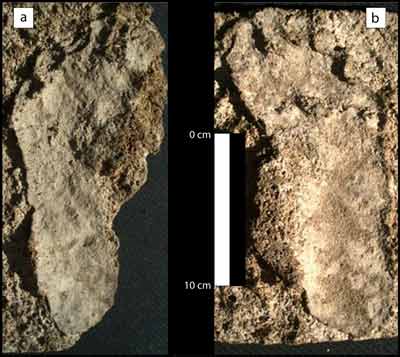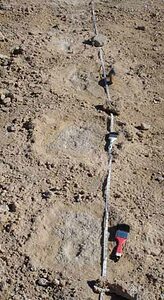
In a fantastic discovery, a team of archaeologists have dated a pair of footprints preserved in the mineral-rich sediment in the Chihuahuan Desert to find that these are 10,500 years old. These are the oldest human footprints discovered thus far in North America, predating any previous find by some 5,000 years. Moreover, the footprints mark for the oldest archaeological find in the region and help paint a broader picture of how early human culture might have been at the time.
Only two tracks were preserved, left and right. These were discovered about 300 kilometers from the Texas border, in 1961, during digs for a highway construction. Luckily these were well preserved and were taken to the local museum. The bad part is that the precise location where the footprints were excavated has been lost. In 2006, a follow-up effort led by Dr. Nicholas Felstead, a geoarchaeologist at Durham University, tried to locate the original site only to find an additional 11 tracks somewhere in the vicinity of the supposed original site. Apparently, these didn’t belong to the hunter-gatherer that roamed those lands some 10,500 years ago, nor were the tracks made during the same millennium for that matter as dating revealed that these were about 7,250 years old.
“Both sets of prints are ones that have been identified before and are the only reported footprints in the Cuatro Ciénegas Basin, but neither have previously been dated,” Felstead said in an interview.
An ancient ‘walk of fame’

It’s the region’s favorable climate of some thousand of years ago that we have to thank for the preservation of these remarkable time capsules. The desert refuge known as Cuatro Ciénegas is marshy and filled with carbonate-rich sediments. Although very rare, through some stroke of luck and exactly favorable conditions the tracks left in the muddy soil solidified and turned into rock (travertine). This sedimentary rock, well known to geologists, contains minute traces of uranium which decays in the element thorium at predictable rates. By measuring the uranium/thorium ratios, the researchers were able to estimate the age of the footprint pair. Their results showed that the pair of tracks discovered in 1961, now housed at Saltillo’s Museo del Desierto, were about 10,550 years old.
Previously, other footprints were discovered after being preserved in similar conditions throughout North America, from Nicaragua to California. The oldest of these are still some thousands of years earlier than the Cuatro Ciénegas footprint pair or the other 11 tracks found in the vicinity for that matter. Concerning the 11 tracks, which are 7,200-year-old, the researchers also discovered traces of ancient pollen from trees like pecan and willow. This type of fauna suggests that the climate back then was much wetter and colder than it is today.
Leaving their mark
This is extremely valuable information, since archaeologists know very little about the humans that inhabited this region. Around the time the oldest North American tracks were made, a diverse group of nomadic hunter-gatherers that ranged from central Mexico to the Texas plains lived there known as the Coahuiltecans. Although they were present in the region for thousand of years, remarkably enough these people left little vestiges to tell of their life there. Previously, the reported human fossil evidence in the area were coprolites — fossil feces — found in a rockshelter dated to about 9,000 years ago. This means that officially, the footprint pair is now also the oldest archaeological evidence reported from the Cuatro Ciénegas Basin.
The oldest human footprints discovered, however, belonged to a child and were made some 13,000 years ago in modern day Chile. The findings were reported in a paper published in the journal Journal of Archaeological Science.
ZME readers, judging from the photo, what shoe size do you think would have fitted the hunter-gather? My guess is an 8.






